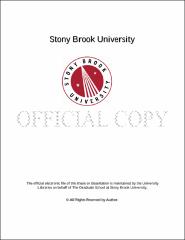| dc.identifier.uri | http://hdl.handle.net/11401/76714 | |
| dc.description.sponsorship | This work is sponsored by the Stony Brook University Graduate School in compliance with the requirements for completion of degree. | en_US |
| dc.format | Monograph | |
| dc.format.medium | Electronic Resource | en_US |
| dc.language.iso | en_US | |
| dc.publisher | The Graduate School, Stony Brook University: Stony Brook, NY. | |
| dc.type | Dissertation | |
| dcterms.abstract | To investigate the dynamic evolution of gas across spiral arms, we conducted a detailed study of the gas and star formation along the spiral arms in the Whirlpool Galaxy, M51. This nearby, face-on spiral galaxy provides a unique laboratory to study the relationship between gas dynamics and star formation. The textbook picture of interstellar medium (ISM) evolution is rapidly changing. Molecular gas was once believed to form along spiral arms from the diffuse atomic gas in the inter-arm regions. Star formation occurs within giant molecular clouds during spiral arm passage. Lastly, the molecular gas is photo-dissociated back into atomic gas by massive stars on the downstream side of the spiral arm. Recent evidence, however, is revealing a new picture of the interstellar medium and the process of star formation. We seek development of a new picture by studying the development and evolution of molecular gas and the role of large scale galactic dynamics in organizing the interstellar medium. This thesis begins by presenting work measuring the geometrical offsets between interstellar gas and recent star formation. Interstellar gas is traced by atomic hydrogen and carbon monoxide (CO). Star formation is traced by ionized hydrogen recombination lines and infrared emission from dust warmed by young bright stars. Measuring these offsets can help determine the underlying large scale galactic dynamics. Along the spiral arms in M51, offsets between CO and the star formation tracers suggest that gas is flowing through the spiral arms, but the offsets do not show the expected signature of a single pattern speed and imply a more complicated pattern. This thesis also examines the intermediate stages of gas evolution, by studying a denser component of the ISM closer to which stars will form. Only a small percent of the bulk molecular gas will become dense enough to form stars. HCN and HCO+ probe densities ~10^4 cm^-3, where as the bulk gas is 500 cm^-3. This thesis looks at HCN and HCO+ emission in M51 across the central 7 kpc disk and localized along a region of spiral arm. This work combines observations that were made with the Green Bank Telescope (GBT) and higher resolution data using the Combined Array for Research In Millimeter-wave Astronomy (CARMA). These observations show dense gas tracers are localized along the star forming spiral arms. In particular, there are regions where dense gas is present but there is no evidence of massive star formation. This may imply that the local environmental conditions, like temperature and velocity dispersion, or small scale physical processes, like turbulence and local gravitational collapse, are important for determining which gas will form stars. This new data also tests an existing relationship between dense gas and infrared emission. Previous work shows a linear relationship connecting distant galaxies and local star forming regions in our own galaxy. These new observations in M51 help fill in the four magnitude gap separating the galaxies and the star forming regions. The presence of an offset between observations in nearby galaxies suggest a change to the hypothesis of HCN tracing a `basic unit of star formation' by include a secondary effect regulated by either the conversion from mass to light or the star formation efficiency. | |
| dcterms.available | 2017-09-20T16:51:02Z | |
| dcterms.contributor | Calder, Alan | en_US |
| dcterms.contributor | Koda, Jin | en_US |
| dcterms.contributor | Fernandez-Serra, Maria | en_US |
| dcterms.contributor | Arce, Hector. | en_US |
| dcterms.creator | Louie, Melissa Nicole | |
| dcterms.dateAccepted | 2017-09-20T16:51:02Z | |
| dcterms.dateSubmitted | 2017-09-20T16:51:02Z | |
| dcterms.description | Department of Physics. | en_US |
| dcterms.extent | 146 pg. | en_US |
| dcterms.format | Application/PDF | en_US |
| dcterms.format | Monograph | |
| dcterms.identifier | http://hdl.handle.net/11401/76714 | |
| dcterms.issued | 2015-12-01 | |
| dcterms.language | en_US | |
| dcterms.provenance | Made available in DSpace on 2017-09-20T16:51:02Z (GMT). No. of bitstreams: 1
Louie_grad.sunysb_0771E_12577.pdf: 38341258 bytes, checksum: 259e8195f2037e11db2d58352e401a12 (MD5)
Previous issue date: 1 | en |
| dcterms.publisher | The Graduate School, Stony Brook University: Stony Brook, NY. | |
| dcterms.subject | Astrophysics | |
| dcterms.subject | CO, galaxy, HCN, HCO+, M51, star formation | |
| dcterms.title | Evolution of Gas Across Spiral Arms in the Whirlpool Galaxy | |
| dcterms.type | Dissertation | |

